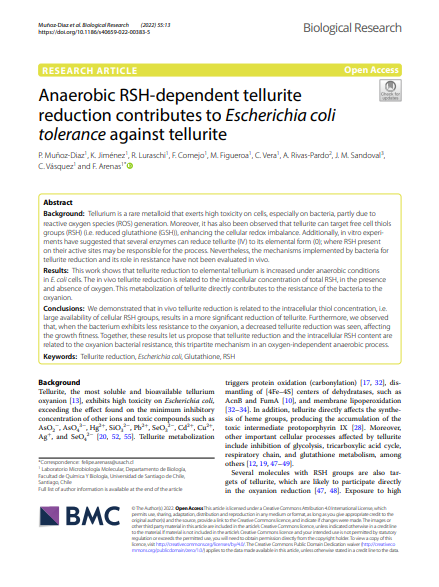Anaerobic RSH-dependent tellurite reduction contributes to Escherichia coli tolerance against tellurite

Fecha
2022-03Autor
Muñoz-Diaz, P.
Jiménez, K.
Luraschi, R.
Cornejo, F.
Figueroa, M.
Vera, C.
Rivas-Pardo, A. [Univ Mayor, Ctr Genom & Bioinformat, Lab Genom Microbiana, Chile]
Sandoval, J. M.
Vásquez, C.
Arenas, F.
Ubicación geográfica
Notas
HERRAMIENTAS
Acceda a títulos restringidos
¿Cómo descargar?Resumen
Background Tellurium is a rare metalloid that exerts high toxicity on cells, especially on bacteria, partly due to reactive oxygen species (ROS) generation. Moreover, it has also been observed that tellurite can target free cell thiols groups (RSH) (i.e. reduced glutathione (GSH)), enhancing the cellular redox imbalance. Additionally, in vitro experiments have suggested that several enzymes can reduce tellurite (IV) to its elemental form (0); where RSH present on their active sites may be responsible for the process. Nevertheless, the mechanisms implemented by bacteria for tellurite reduction and its role in resistance have not been evaluated in vivo. Results This work shows that tellurite reduction to elemental tellurium is increased under anaerobic conditions in E. coli cells. The in vivo tellurite reduction is related to the intracellular concentration of total RSH, in the presence and absence of oxygen. This metabolization of tellurite directly contributes to the resistance of the bacteria to the oxyanion. Conclusions We demonstrated that in vivo tellurite reduction is related to the intracellular thiol concentration, i.e. large availability of cellular RSH groups, results in a more significant reduction of tellurite. Furthermore, we observed that, when the bacterium exhibits less resistance to the oxyanion, a decreased tellurite reduction was seen, affecting the growth fitness. Together, these results let us propose that tellurite reduction and the intracellular RSH content are related to the oxyanion bacterial resistance, this tripartite mechanism in an oxygen-independent anaerobic process.
URI
https://repositorio.umayor.cl/xmlui/handle/sibum/9232https://www.scielo.cl/pdf/bres/v55/0717-6287-bres-55-13.pdf
http://dx.doi.org/10.1186/s40659-022-00383-5
https://www.ncbi.nlm.nih.gov/pmc/articles/PMC8935827/pdf/40659_2022_Article_383.pdf
https://biolres.biomedcentral.com/counter/pdf/10.1186/s40659-022-00383-5.pdf
Coleccion/es a la/s que pertenece:
Si usted es autor(a) de este documento y NO desea que su publicación tenga acceso público en este repositorio, por favor complete el formulario aquí.